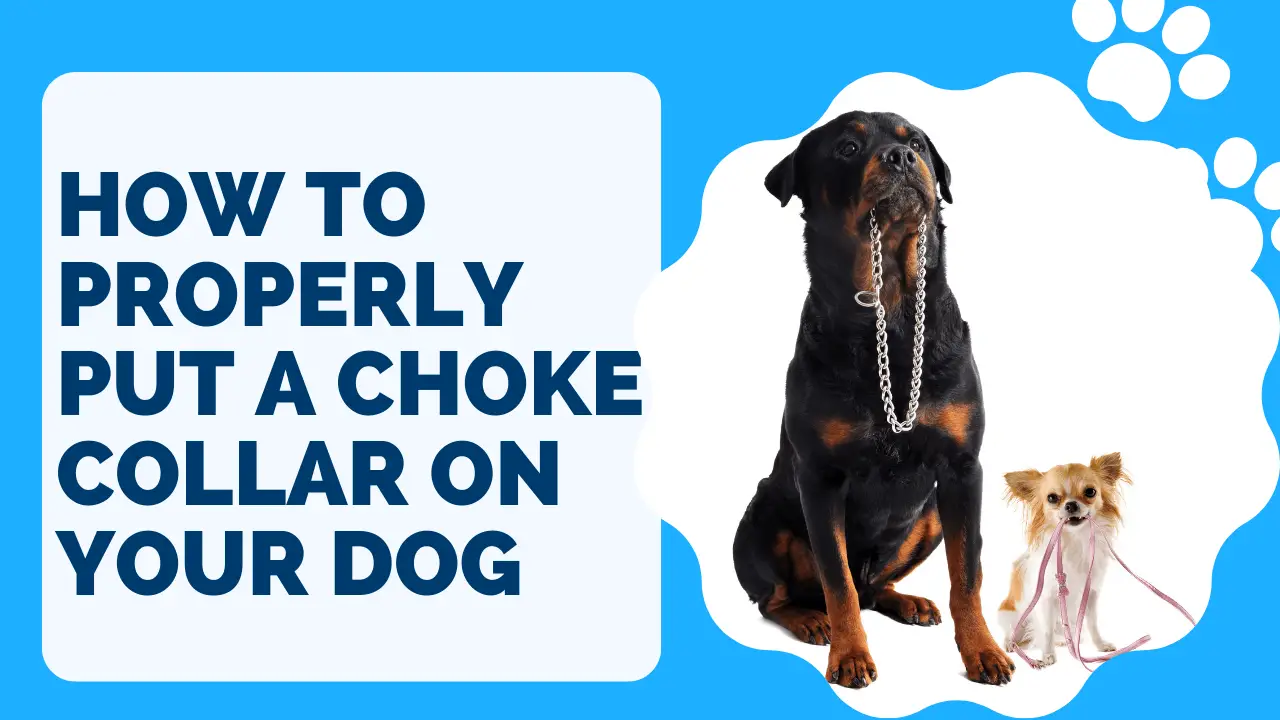Putting a choke collar on a dog can be daunting for first-time pet owners. However, it is an essential skill to learn for those who want to train their dogs effectively. A choke collar, a slip collar, or a training collar is used to correct a dog’s behavior during training. It is designed to tighten around the dog’s neck when the leash is pulled, creating a choking sensation that discourages the dog from pulling or misbehaving.
Before putting on a choke collar, it is crucial to understand how it works and how to use it correctly. Misusing a choke collar can cause harm to your dog and may even lead to injury. It is recommended to seek guidance from a professional dog trainer or veterinarian before using a choke collar on your dog. This article will provide a step-by-step guide on putting a choke collar on a dog and using it safely and effectively during training.
Choosing the Right Choke Collar
When choosing a choke collar for your dog, there are a few things to consider to ensure you pick the right one. A suitable collar can make all the difference in your dog’s safety and comfort, as well as the effectiveness of the training.
Size Matters
Size is one of the most important factors when choosing a choke collar. It is crucial to select the right size to ensure that the collar fits properly and functions correctly. A too-loose collar can slip off, while a too-tight collar can cause discomfort and injury to your dog.
To determine the correct size, measure your dog’s neck circumference with a tape measure. Then, add two inches to the measurement to get the right size for the collar. For example, if your dog’s neck measures 14 inches, you should choose a collar that is 16 inches in length.
Correct Size for the Breed
It is also essential to consider your dog’s breed when choosing a choke collar. Different species have different neck sizes and shapes, meaning not all collars fit all breeds.
For example, a Greyhound has a long, slender neck, while a Bulldog has a short, thick neck. Therefore, a collar that fits a Greyhound may not fit a Bulldog properly. Choosing a collar for your dog’s breed is essential to ensure a proper fit.
Choose the Right Material
Another factor to consider when choosing a choke collar is the material. Choke collars are available in various materials, including leather, nylon, and metal.
Leather collars are durable and comfortable for your dog, while nylon collars are lightweight and easy to clean. Metal collars are the most durable option, but they can be heavy and uncomfortable for some dogs.
Final Thoughts
Choosing the suitable choke collar for your dog is an important decision that requires careful consideration. By taking the time to measure your dog’s neck, considering the breed, and choosing the suitable material, you can ensure that you pick a collar that is safe, effective, and comfortable for your furry friend.
Correct Positioning of a Choke Collar
When using a choke collar on a dog, correct positioning is crucial to ensure the safety and comfort of the animal. The collar should be placed high on the dog’s neck, just under the ears. This will keep the chain away from the more sensitive and easily damaged trachea lower down.
Ideally, the collar should be positioned in a P shape, with the live ring at the top of the P and the chain hanging down through the ring. This will ensure that the collar tightens quickly and efficiently when pressure is applied to the leash and releases just as quickly when the pressure is released.
When walking with a dog on a choke collar, it is recommended to walk on the right-hand side of the dog. This allows the handler to keep the leash in their left hand and apply pressure to the collar with their right hand if necessary.
It is important to note that choke collars should never be left on a dog unattended, as they can become caught on objects and cause injury. Also, choke collars should only be used for training, not as permanent for everyday wear.
By positioning the choke collar correctly and using it responsibly, handlers can effectively train their dogs while keeping them safe and comfortable.
How to Put On a Choke Collar
Putting on a choke collar can be tricky, but it can be done safely and effectively with the proper steps. Here are some steps to follow:
Step 1: Choose the Right Size
First, ensure you have the correct size choke collar for your dog. The collar should fit snugly around the dog’s neck but not tight. It should be loose enough to allow you to fit two fingers between the collar and the dog’s neck.
Step 2: Position the Collar
Next, position the collar on the dog’s neck, just under the ears. This will keep the chain away from the more sensitive and easily damaged trachea lower down. Ideally, the collar should sit at the narrowest part of the neck, just behind the ears.
Step 3: Fasten the Collar
Once you have the collar in position, fasten it securely. The collar should be tight enough that it won’t slip off but not so tight that it chokes the dog. You should be able to fit two fingers between the collar and the dog’s neck.
Step 4: Check the Fit
After you’ve fastened the collar, recheck the fit. Make sure the collar is snug but not too tight. It won’t be effective if it is too loose, and if it is too tight, it can harm the dog.
Step 5: Attach the Leash
Finally, attach the leash to the choke collar. Ensure the leash is attached to the ring on the collar that is furthest away from the dog’s head. This will ensure that the collar tightens when you pull on the leash.
Remember, choke collars should only be used for training purposes and should never be left on the dog unsupervised. Consult a professional dog trainer for advice if you have any concerns about using a choke collar.
Using a Choke Collar for Training
A choke collar is a training tool to teach a dog basic obedience commands. It is a collar that tightens around the dog’s neck when pulled and is typically used during training sessions with a professional dog trainer. While it can be an effective tool in the right hands, it is also controversial and dangerous if misused.
When using a choke collar for training, working with a professional dog trainer with experience using this tool is essential. The trainer should know how to fit the collar properly, use it during training sessions, and avoid injury to the dog.
During training sessions, the trainer will use the choke collar to correct the dog when it does not obey a command. It is important to note that the choke collar should never be used to punish or harm the dog but rather to redirect its attention and reinforce basic obedience commands.
It is also essential to use the choke collar sparingly and to gradually decrease its use as the dog becomes more obedient. Overusing the choke collar can lead to injury or discomfort and cause the dog to become fearful or aggressive.
In addition to using a choke collar, it is essential to provide positive reinforcement during training sessions. This can include treats, praise, and playtime with the dog. By combining positive reinforcement with a choke collar, the dog can learn basic obedience commands and become a well-behaved family member.
Ensuring Comfort and Safety
When using a choke collar on a dog, it is crucial to ensure their comfort and safety. Improper use of the collar can cause pain, injury, and even harm to the dog. Therefore, it is essential to use the collar safely and correctly.
One of the most important things to consider is the pressure the collar exerts on the dog’s neck. The collar should be loose enough to allow the dog to breathe comfortably but tight enough to prevent it from slipping off. A good rule of thumb is to ensure you can fit two fingers between the collar and the dog’s neck.
It is also essential to avoid putting too much force on the collar. Pulling the leash too hard can cause pain and discomfort to the dog, which can lead to injuries. Instead, use gentle pressure to guide the dog and correct their behavior.
Misuse or improper use of the choke collar can also be dangerous. For example, if the collar is too tight, it can cause neck injuries, trachea, or esophagus damage. Therefore, it is crucial to use the collar only when necessary and to avoid using it as a punishment tool.
In conclusion, using a choke collar on a dog can be a safe and effective way to correct their behavior. However, it is essential to ensure the dog’s comfort and safety by using the collar correctly and avoiding misuse. Following these guidelines, owners can safely use choke collars to train their dogs.
Potential Risks and Controversies
Choke collars have been debated among dog owners and professional trainers for years. While some trainers recommend using choke collars as a punishment tool to correct unwanted behavior, others argue that it can cause discomfort, fear, and even physical harm to the dog.
One of the main concerns with choke collars is the potential for punishment. When misused, choke collars can cause the dog pain and discomfort, leading to fear and anxiety. This can be especially problematic if the dog is already fearful or anxious, as it can worsen the behavior and make correcting it more challenging.
Another risk associated with choke collars is the potential for physical harm. If the collar is not fitted correctly, it can cause damage to the dog’s neck, throat, and trachea. This can be especially dangerous for dogs with pre-existing health conditions or those prone to respiratory problems.
Dog owners need to understand that choke collars should be approached with caution. Professional trainers recommend using positive reinforcement techniques to correct unwanted behavior rather than relying on punishment. Consistency is vital when training a dog, and it is important to be receptive to the dog’s needs and adjust the training accordingly.
Desensitization is also important in training a dog to wear a choke collar. This involves gradually introducing the collar to the dog and allowing them to become comfortable with it over time. This can help to reduce any fear or discomfort associated with the collar and make it easier to use as a training tool.
In conclusion, choke collars can be an effective training tool, but they should be cautiously approached. Dog owners should be aware of the potential risks and controversies associated with choke collars and should always prioritize the safety and well-being of their furry friends.
Frequently Asked Questions
What are the pros and cons of using a choke collar for dog training?
Choke collars are a controversial training tool for dogs. The pros of using a choke collar include that it can effectively control a dog that pulls on the leash, and it can help train aggressive or disobedient dogs. The cons of using a choke collar include that it can cause injury to the dog if misused, leading to fear and anxiety in dogs, and can cause damage to the dog’s trachea and neck.
What is the best type of choke collar for dogs?
The best type of choke collar for dogs is a martingale collar. Martingale collars are designed to prevent choking and dog neck injury. They are made with a loop of material that tightens when the dog pulls but will not tighten to the point of choking the dog. This type of collar is a safer alternative to traditional choke collars.
How do you properly fit a choke collar on a dog?
To properly fit a choke collar on a dog, it should be placed high on its neck, just behind the ears. It should be loose enough to slide over the dog’s head but not so loose that it will fall off. The collar should be adjusted so it sits high on the dog’s neck, and the rings should be centered at the back of the dog’s neck.
Can a choke collar hurt a dog?
Yes, a choke collar can hurt a dog if misused. If the collar is too tight, it can cause injury to the dog’s neck and trachea. It can also cause fear and anxiety in the dog, leading to behavioral problems.
Are choke collars legal to use on dogs?
Choke collars are legal to use on dogs in most places, but there are some areas where they are banned. It is essential to check the local laws and regulations before using a choke collar on a dog.
Will a choke collar stop a dog from pulling?
A choke collar can effectively stop a dog from pulling, but it is not a long-term solution. Training the dog properly and using positive reinforcement techniques to encourage good behavior is essential. A choke collar should only be used as a last resort, and it should be used sparingly and with caution.



